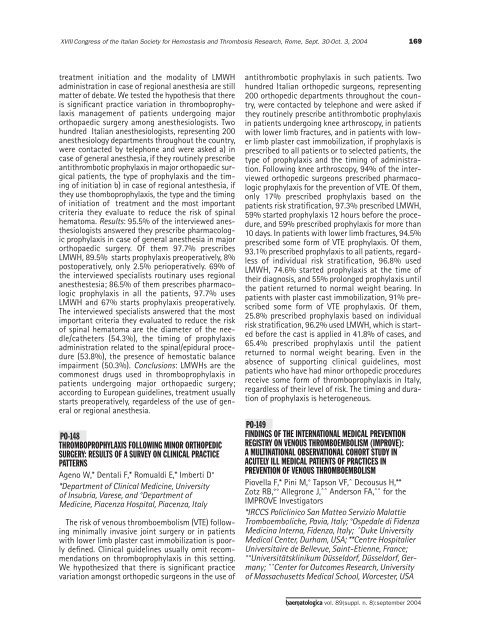Haematologica 2004;89: supplement no. 8 - Supplements ...
Haematologica 2004;89: supplement no. 8 - Supplements ...
Haematologica 2004;89: supplement no. 8 - Supplements ...
- No tags were found...
Create successful ePaper yourself
Turn your PDF publications into a flip-book with our unique Google optimized e-Paper software.
XVIII Congress of the Italian Society for Hemostasis and Thrombosis Research, Rome, Sept. 30-Oct. 3, <strong>2004</strong>169treatment initiation and the modality of LMWHadministration in case of regional anesthesia are stillmatter of debate. We tested the hypothesis that thereis significant practice variation in thromboprophylaxismanagement of patients undergoing majororthopaedic surgery among anesthesiologists. Twohundred Italian anesthesiologists, representing 200anesthesiology departments throughout the country,were contacted by telephone and were asked a) incase of general anesthesia, if they routinely prescribeantithrombotic prophylaxis in major orthopaedic surgicalpatients, the type of prophylaxis and the timingof initiation b) in case of regional antesthesia, ifthey use thomboprophylaxis, the type and the timingof initiation of treatment and the most importantcriteria they evaluate to reduce the risk of spinalhematoma. Results: 95.5% of the interviewed anesthesiologistsanswered they prescribe pharmacologicprophylaxis in case of general anesthesia in majororthopaedic surgery. Of them 97.7% prescribesLMWH, <strong>89</strong>.5% starts prophylaxis preoperatively, 8%postoperatively, only 2.5% perioperatively. 69% ofthe interviewed specialists routinary uses regionalanesthestesia; 86.5% of them prescribes pharmacologicprophylaxis in all the patients, 97.7% usesLMWH and 67% starts prophylaxis preoperatively.The interviewed specialists answered that the mostimportant criteria they evaluated to reduce the riskof spinal hematoma are the diameter of the needle/catheters(54.3%), the timing of prophylaxisadministration related to the spinal/epidural procedure(53.8%), the presence of hemostatic balanceimpairment (50.3%). Conclusions: LMWHs are thecommonest drugs used in thromboprophylaxis inpatients undergoing major orthopaedic surgery;according to European guidelines, treatment usuallystarts preoperatively, regardeless of the use of generalor regional anesthesia.PO-148THROMBOPROPHYLAXIS FOLLOWING MINOR ORTHOPEDICSURGERY: RESULTS OF A SURVEY ON CLINICAL PRACTICEPATTERNSAge<strong>no</strong> W,* Dentali F,* Romualdi E,* Imberti D°*Department of Clinical Medicine, Universityof Insubria, Varese, and °Department ofMedicine, Piacenza Hospital, Piacenza, ItalyThe risk of ve<strong>no</strong>us thromboembolism (VTE) followingminimally invasive joint surgery or in patientswith lower limb plaster cast immobilization is poorlydefined. Clinical guidelines usually omit recommendationson thromboprophylaxis in this setting.We hypothesized that there is significant practicevariation amongst orthopedic surgeons in the use ofantithrombotic prophylaxis in such patients. Twohundred Italian orthopedic surgeons, representing200 orthopedic departments throughout the country,were contacted by telephone and were asked ifthey routinely prescribe antithrombotic prophylaxisin patients undergoing knee arthroscopy, in patientswith lower limb fractures, and in patients with lowerlimb plaster cast immobilization, if prophylaxis isprescribed to all patients or to selected patients, thetype of prophylaxis and the timing of administration.Following knee arthroscopy, 94% of the interviewedorthopedic surgeons prescribed pharmacologicprophylaxis for the prevention of VTE. Of them,only 17% prescribed prophylaxis based on thepatients risk stratification, 97.3% prescribed LMWH,59% started prophylaxis 12 hours before the procedure,and 59% prescribed prophylaxis for more than10 days. In patients with lower limb fractures, 94.5%prescribed some form of VTE prophylaxis. Of them,93.1% prescribed prophylaxis to all patients, regardlessof individual risk stratification, 96.8% usedLMWH, 74.6% started prophylaxis at the time oftheir diag<strong>no</strong>sis, and 55% prolonged prophylaxis untilthe patient returned to <strong>no</strong>rmal weight bearing. Inpatients with plaster cast immobilization, 91% prescribedsome form of VTE prophylaxis. Of them,25.8% prescribed prophylaxis based on individualrisk stratification, 96.2% used LMWH, which is startedbefore the cast is applied in 41.8% of cases, and65.4% prescribed prophylaxis until the patientreturned to <strong>no</strong>rmal weight bearing. Even in theabsence of supporting clinical guidelines, mostpatients who have had mi<strong>no</strong>r orthopedic proceduresreceive some form of thromboprophylaxis in Italy,regardless of their level of risk. The timing and duratio<strong>no</strong>f prophylaxis is heterogeneous.PO-149FINDINGS OF THE INTERNATIONAL MEDICAL PREVENTIONREGISTRY ON VENOUS THROMBOEMBOLISM (IMPROVE):A MULTINATIONAL OBSERVATIONAL COHORT STUDY INACUTELY ILL MEDICAL PATIENTS OF PRACTICES INPREVENTION OF VENOUS THROMBOEMBOLISMPiovella F,* Pini M,° Tapson VF,^ Decousus H,**Zotz RB,°° Allegrone J,^^ Anderson FA,^^ for theIMPROVE Investigators*IRCCS Policlinico San Matteo Servizio MalattieTromboemboliche, Pavia, Italy; °Ospedale di FidenzaMedicina Interna, Fidenza, Italy; ^Duke UniversityMedical Center, Durham, USA; **Centre HospitalierUniversitaire de Bellevue, Saint-Etienne, France;°°Universitätsklinikum Düsseldorf, Düsseldorf, Germany;^^Center for Outcomes Research, Universityof Massachusetts Medical School, Worcester, USAhaematologica vol. <strong>89</strong>(suppl. n. 8):september <strong>2004</strong>
















